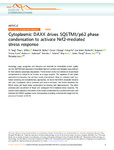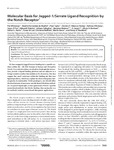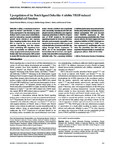A holistic approach to dissecting SPARC family protein complexity reveals FSTL-1 as an inhibitor of pancreatic cancer cell growth

Date
2016Author
Subject
Metadata
Show full item recordAbstract
<jats:title>Abstract</jats:title><jats:p>SPARC is a matricellular protein that is involved in both pancreatic cancer and diabetes. It belongs to a wider family of proteins that share structural and functional similarities. Relatively little is known about this extended family, but evidence of regulatory interactions suggests the importance of a holistic approach to their study. We show that Hevin, SPOCKs, and SMOCs are strongly expressed within islets, ducts, and blood vessels, suggesting important roles for these proteins in the normal pancreas, while FSTL-1 expression is localised to the stromal compartment reminiscent of SPARC. In direct contrast to SPARC, however, FSTL-1 expression is reduced in pancreatic cancer. Consistent with this, FSTL-1 inhibited pancreatic cancer cell proliferation. The complexity of SPARC family proteins is further revealed by the detection of multiple cell-type specific isoforms that arise due to a combination of post-translational modification and alternative splicing. Identification of splice variants lacking a signal peptide suggests the existence of novel intracellular isoforms. This study underlines the importance of addressing the complexity of the SPARC family and provides a new framework to explain their controversial and contradictory effects. We also demonstrate for the first time that FSTL-1 suppresses pancreatic cancer cell growth.</jats:p>
Collections
Publisher
Place of Publication
Journal
Volume
Issue
Pagination
Author URL
Number
Recommended, similar items
The following license files are associated with this item:
Related items
Showing items related by title, author, creator and subject.
-
Cytoplasmic DAXX drives SQSTM1/p62 phase condensation to activate Nrf2-mediated stress response
Yang, Y; Willis, TL; Button, RW; Strang, CJ; Fu, Y; Wen, X; Grayson, PRC; Evans, T; Sipthorpe, RJ; Roberts, SL; Hu, Bing; Zhang, J; Lu, B; Luo, Shouqing (Springer Science and Business Media LLCEngland, 2019-08-21)<jats:title>Abstract</jats:title><jats:p>Autophagy cargo recognition and clearance are essential for intracellular protein quality control. SQSTM1/p62 sequesters intracellular aberrant proteins and mediates cargo delivery ... -
Molecular basis for Jagged-1/Serrate ligand recognition by the Notch receptor.
Whiteman, P; de Madrid, BH; Taylor, P; Li, D; Heslop, R; Viticheep, N; Tan, JZ; Shimizu, H; Callaghan, J; Masiero, M; Li, JL; Banham, AH; Harris, AL; Lea, SM; Redfield, C; Baron, M; Handford, PA (United States, 2013-03-08)We have mapped a Jagged/Serrate-binding site to specific residues within the 12th EGF domain of human and Drosophila Notch. Two critical residues, involved in a hydrophobic interaction, provide a ligand-binding platform ... -
Up-regulation of the Notch ligand Delta-like 4 inhibits VEGF-induced endothelial cell function.
Williams, CK; Li, J-L; Murga, M; Harris, AL; Tosato, G (United States, 2006-02-01)Delta-like 4 (Dll4), a membrane-bound ligand for Notch1 and Notch4, is selectively expressed in the developing endothelium and in some tumor endothelium, and it is induced by vascular endothelial growth factor (VEGF)-A ...




